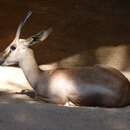Biology
provided by Arkive
Feeding on herbs and shrubs in the summer, and green grasses in the winter, Cuvier's gazelle will browse during the night and early morning in the valleys, moving into the hills during the day (2). It regularly visits waterholes to drink (2), and will patrol its territory, marking the boundaries with urine, dung and secretions from glands beneath their eyes (6). Each territory is home to one male and one or more females with their young (2). Males may clash, performing threat displays with the head raised and horns lying along the back, before lowering the head, interlocking the horns and pushing and twisting to gain dominance (6).
Mating occurs in early winter and females give birth in the spring, around 170 days later, in time for the first flush of vegetation following the rains. Most pregnancies result in a single calf, but twins are not uncommon. Mature females can have two litters in a year if conditions are good, but this is fairly unusual (2). Newborns stay hidden amongst grasses for the first few weeks of life to reduce the risk of predation. Cuvier's gazelle is a nervous and hasty antelope species that signals alarm with a flick of the tail, and will make bouncing leaps with the head held high (stotting) to announce that they have seen a predator (6).
Conservation
provided by Arkive
Whilst Cuvier's gazelle occurs mainly in protected areas in Tunisia, this is not the case in Morocco and Algeria (2) (7). With a large stock of captive animals, re-introduction programmes are underway in some of its former range (Tunisia) (5) (7). Suitable habitat is available, but safe corridors between protected areas, as well as access to waterholes, are needed to enable Cuvier's gazelle to re-establish itself successfully in these regions. The Centre for Saharan Fauna in Almeria, Spain has the largest captive population of Cuvier's gazelle, but there are others, including North America (5).
Description
provided by Arkive
Cuvier's gazelle has two-tone colouration; a dark brown back, head and legs contrast with a white belly and rump patch. The tail is nearly black and the top of the nose has a conspicuous black spot. The face has black stripes running from the enormous ears to the nose. It has vertical, spiralled horns that are present in both sexes, and may reach 35 centimetres in length (5).
Habitat
provided by Arkive
Cuvier's gazelle is found in a wide range of habitats, including open oak forests, pine forests, open country, grasslands, vineyards and stony desert plateaus. It occurs only at high altitude in the Atlas Mountains (2) (5).
Range
provided by Arkive
At the start of the 20th Century, Cuvier's gazelle was still quite numerous on the Moroccan mountains, as well as in Algeria and western Tunisia. However, by 1932 the population had dropped significantly, and by 1972 only small herds remained in the Atlas Mountains. At present it is found in tiny populations in the higher regions of Algeria, Morocco and Tunisia (2) (5).
Status
provided by Arkive
Cuvier's gazelle is classified as Endangered on the IUCN Red List 2007 (1) and is listed on Appendix I of CITES (3). It is also listed on Appendix I of the Convention on Migratory Species (CMS or Bonn Convention) (4).
Threats
provided by Arkive
The decline of Cuvier's gazelle in the first half of the 20th Century was caused by hunting for skins, meat and sport. Currently, the decline continues due to the conversion of habitat to agricultural land and grazing grounds for livestock (2).

